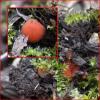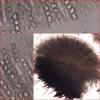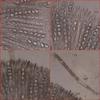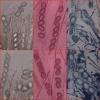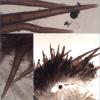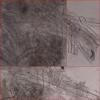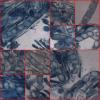
08-02-2015 16:42
Lepista ZacariasI would like to have your help to identify this Sc

10-02-2015 00:23
 Jenny Seawright
Jenny Seawright
Hello all, This seems to be Propolomyces versicolo

11-02-2015 08:39
Bonjour. Je ai un rassemblement de 02.02.2015 de

09-02-2015 16:47
 Carlo Agnello
Carlo Agnello
Dear FriendsI want to show a nice discovery of pin

09-02-2015 17:36
Chris JohnsonGreetings,Gregarious colony on the bark of a dead

09-02-2015 19:19
Hi to all We have found these pustulate, ellipsoi

09-02-2015 13:25
Gernot FriebesHi,I recently found this species on the bark of a
2014-02-07-Scutellinia
Lepista Zacarias,
08-02-2015 16:42
Thank you in advance,
zaca
Data:
A few apothecia growing on soil under shrubs;
Spores:
(13.8) 16.1 - 18.8 (19.7) x (10) 11.5 - 13.8 (15.1) µm
Q = (1.3) 1.33 - 1.49 (1.5) ; N = 50
Me = 17.4 x 12.4 µm ; Qe = 1.4
Asci: 220-260 x 12-16 µm;
Paraphysis tips globose up to 10 µm in diameter;
Hairs up to 350 x 32 µm.
Beñat Jeannerot,
09-02-2015 06:44

Re : 2014-02-07-Scutellinia
Adio Zaca,
How are you ?
For this collection, impossible to say without spores in BC...
Probably around nigrohirtula complex, but spores seem to be not mature...
Beñat
How are you ?
For this collection, impossible to say without spores in BC...
Probably around nigrohirtula complex, but spores seem to be not mature...
Beñat
Lepista Zacarias,
09-02-2015 11:55
Re : 2014-02-07-Scutellinia
Hi Beñat,
I hope everything is right with you as well.
I suppose that by BC you mean "Bleu de Crésyl". I posted some photos of it in the 4th group; The stain was not very effective; Maybe I have to let the blue act for a litle longer. Anyway, I will do it again (in the last apothecia I have, the collection was really short) and post here the results.
Best regards,
zaca
I hope everything is right with you as well.
I suppose that by BC you mean "Bleu de Crésyl". I posted some photos of it in the 4th group; The stain was not very effective; Maybe I have to let the blue act for a litle longer. Anyway, I will do it again (in the last apothecia I have, the collection was really short) and post here the results.
Best regards,
zaca
Malcolm Greaves,
09-02-2015 16:06
Re : 2014-02-07-Scutellinia
Zaca
The usual stain for Scutellinia spores is Lactophenol Cotton Blue.
Mal
The usual stain for Scutellinia spores is Lactophenol Cotton Blue.
Mal
Lepista Zacarias,
10-02-2015 22:14
Chris Yeates,
11-02-2015 02:12

Re : 2014-02-07-Scutellinia
Hi Zaca
but as Beñat has pointed out the spores are immature and therefore cannot be of any help. See if you can make a spore drop - with a (thin) marker pen draw a small circle on a microscope slide; turn the slide over and place the hymenial surface of the Scutellinia directly over the circle.
If you leave that for a good period of time you can check the dry microscope slide for ejected (mature) spores in the area within the circle under the compound microscope at x100 or x200; if you see spores, mount in Cotton Blue in Lactophenol, heat gently and show the results.
I hope Beñat does not disagree too much with this procedure I often use . . . .
amitiés
Chris
but as Beñat has pointed out the spores are immature and therefore cannot be of any help. See if you can make a spore drop - with a (thin) marker pen draw a small circle on a microscope slide; turn the slide over and place the hymenial surface of the Scutellinia directly over the circle.
If you leave that for a good period of time you can check the dry microscope slide for ejected (mature) spores in the area within the circle under the compound microscope at x100 or x200; if you see spores, mount in Cotton Blue in Lactophenol, heat gently and show the results.
I hope Beñat does not disagree too much with this procedure I often use . . . .
amitiés
Chris
Lepista Zacarias,
12-02-2015 12:14
Re : 2014-02-07-Scutellinia
Thanks, Chris,
for your detailed explanation that certainly will be helpful in future.
Unfortunately this time it didn´t work: in fact, after an entire day I was not able to see any spore. The material was already very scarse.
Regards,
zaca
for your detailed explanation that certainly will be helpful in future.
Unfortunately this time it didn´t work: in fact, after an entire day I was not able to see any spore. The material was already very scarse.
Regards,
zaca

